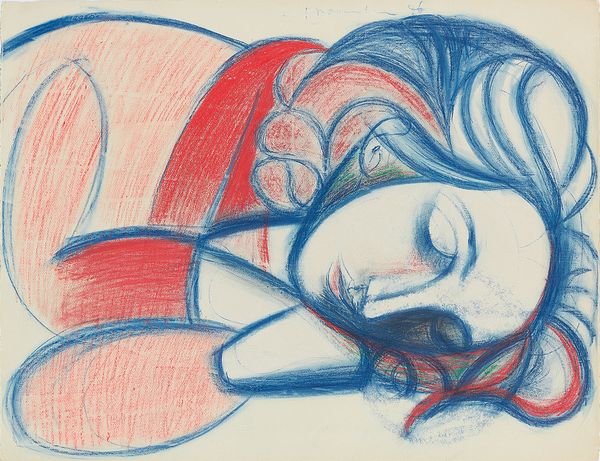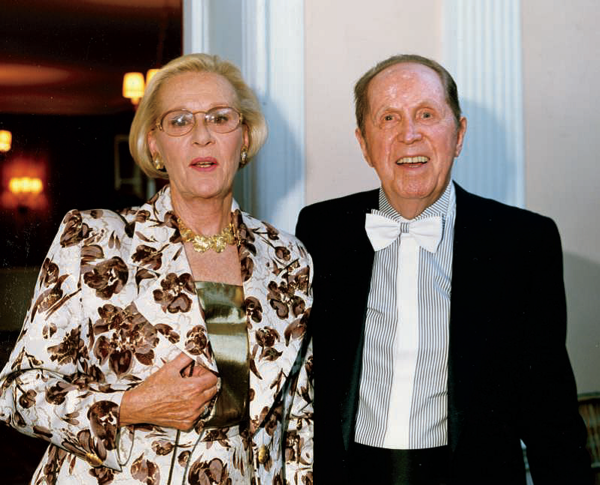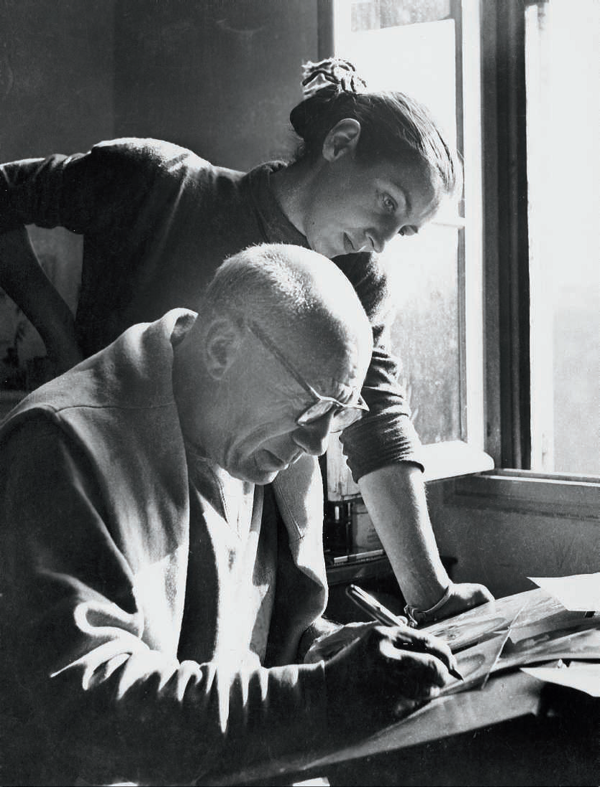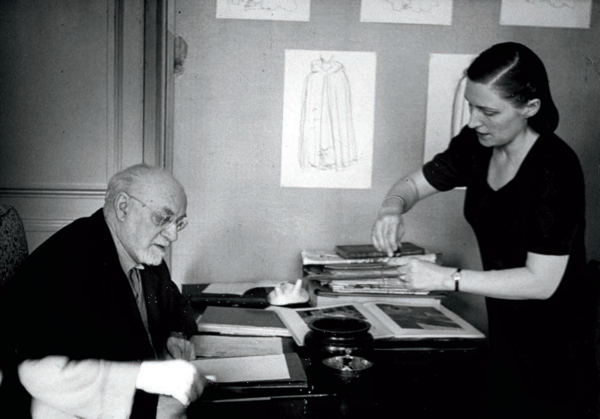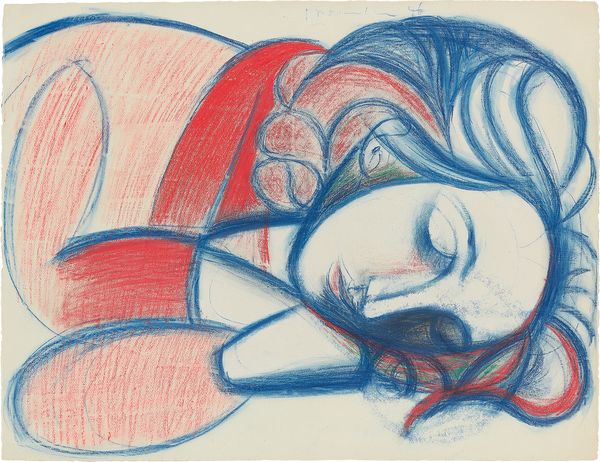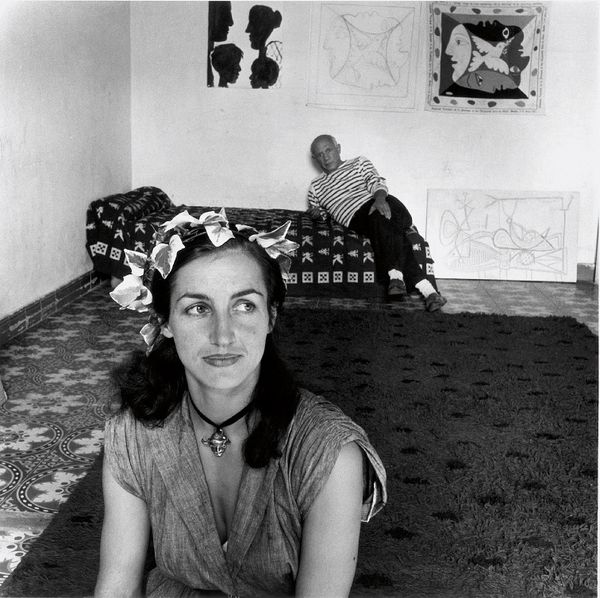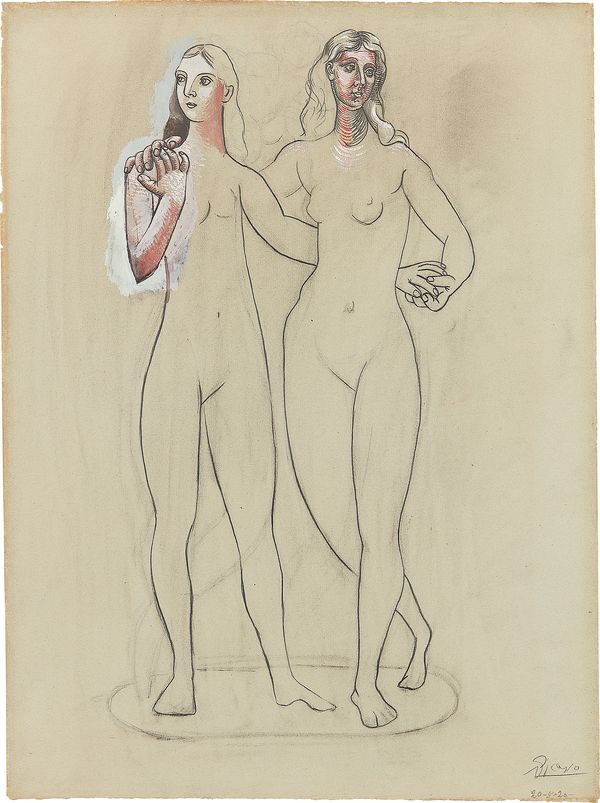Pablo Picasso Femme de Endormie.III, 1946
Best known as Elvis Presley’s music publisher, Julian J. Aberbach and his wife Anne Marie amassed a remarkable collection of modern art. Their discerning taste is evident in the group of four works on paper by Henri Matisse and Pablo Picasso, each of whose depictions of sleeping women are a tribute to the artists’ legendary rivalry and friendship that would change the course of art history forever.
As the founder of the music publishing business Hill and Range, Julian J. Aberbach together with his brother Joachim, or Jean, helped propel stars ranging from Elvis Presley, Johnny Cash and Edith Piaf to international fame—publishing timeless hits as varied as “Frosty the Snowman”, “I Walk the Line” and “Love me Tender”.
Anne Marie and Julian J. Aberbach Anne Marie and Julian J. Aberbach celebrating Julian’s birthday in the 1990s
Elvis Presley in Loving You. Image © John Springer Collection/CORBIS/Corbis via Getty Images
Their unwavering dedication to supporting musicians was perhaps matched only by their shared interest in modern and post-war art, each accumulating significant collections and developing close relationships with several of the artists whose works they collected, including Henry Moore and Fernando Botero. Either jointly or individually, the Aberbach brothers donated works ranging from Francis Bacon to Botero, from Ellsworth Kelly to Willem de Kooning, and from Henri Rousseau to Georges Roualt to a wide-ranging number of institutions including the Metropolitan Museum of Art, New York, the Berkeley Art Museum, the Hood Museum at Dartmouth College and the Rose Art Museum at Brandeis University.
Dr. Charles Stuckey, art historian and former Curator of Modern Painting, National Gallery of Art, Washington D.C. and 20th Century Painting and Sculpture, Art Institute of Chicago, discusses this important group of drawings
Julian and Jean were the sons of a successful Jewish jeweller in Vienna, who instilled in them a strong entrepreneurial spirit. Having made their first modest fortune together selling bed linens, Jean soon moved to Berlin and by chance found employment working in the music industry for Will Meisel. As political tensions rose in the early 1930s with the rise of the Nazi Party, Jean eventually moved from Berlin to Paris. Julian joined him there in 1932 and also entered the music publishing business, carving out a niche by securing royalties for movie screenwriters. Jean soon joined this enterprise, which they successfully sold in 1936. Both brothers subsequently worked as agents for the legendary French music publisher Francis Salabert—Julian in Paris and Jean in the United States. In later years, it was a source of particular pride for Julian to be made a Chevalier of the Légion d’Honneur in France for his contributions to French culture, which had their beginnings in the 1930s but would continue through his work with legends including Edith Piaf in later years.
Julian had crucially registered for immigration at the American consulate during this period, a prescient move. Indeed, with Hitler’s annexation of Austria in 1937, Julian’s parents were increasingly aware of their precarious situation in Vienna. Trying to bring them to the United States, the brothers bought them tickets for the ill-fated St Louis—a ship filled with Jewish refugees that traveled from Hamburg to Havana, but which was then refused permission to dock and ultimately returned to Europe. As memorialized in the book and the movie The Voyage of the Damned, this became a cause célèbre as more than a quarter of passengers would later die during the Holocaust. Julian, who at the time had been in the United States, returned to France to meet his parents in order to bring them to safety. In doing so, Julian himself only narrowly escaped paying the ultimate price for returning to France: he was processed at the notorious Drancy assembly point from which many Jewish prisoners were sent to concentration camps, and often their deaths. Julian had the foresight to take a fever jab beforehand—vomiting on the German doctor inspecting him saved his life, as he was deemed too ill to be of use and was turned away. He soon made his way to Spain, and thence to America. Julian served as an officer in the US military during the Second World War, first helping to command the Free French forces in Fort Benning, Georgia and was later selected for intelligence work, from which he was discharged in 1944 after several years of service due to an injury.
It was during his service in the South that he developed an ear for country music, while also seeing its business potential. By this time, his brother Jean was working for the music publisher and songwriter Max Dreyfus. Through his brother’s contacts, Julian founded Hill and Range in Los Angeles—achieving his breakthrough by signing swing musician Spade Cooley, whom he had seen performing at the Venice Pier Ballroom, and whose “Shame on You” became an instantaneous hit. Julian’s precedent of setting up publishing companies and sharing ownership with the artists formed the basis for arrangements with such performers as Hank Snow, Eddie Arnold and even Johnny Cash. Jean soon joined his brother at Hill and Range. They tended to work from New York and Los Angeles, often meeting in Chicago to discuss business. Their company was expanding internationally by the time Hank Snow pointed Aberbach towards a country-style singer with immense charisma—who didn’t wear cowboy gear. It took time for Aberbach to sign Elvis Presley, but when he did, he also introduced him to “Colonel” Tom Parker, laying the groundwork for one of the 20th century’s most legendary show business partnerships. Elvis’ relationship with Julian and his family was without a doubt one of the cornerstones of his success; Julian and his brother continued to receive royalties for Elvis’ hits for the rest of their lives.
Much of Julian’s life was dictated by fortunate encounters. Perhaps the most important of these was when he asked a young woman by the name of Anne Marie for help choosing lottery numbers in a tabac in Paris, eventually attempting to ask her out for a meal. This was the beginning of a swift romance and a successful half-century-long marriage. As early as the 1950s, Julian and Annie Marie had begun to collect pictures by various artists, not least on his regular trips to Europe. In later years, the Aberbach brothers’ interest in art expanded enormously and even saw them venturing into the dealers’ sphere. Reflecting their incredible business acumen, the brothers had marked success with artists as varied as Friedensreich Hundertwasser, Fernando Botero and Henry Moore. Julian also assisted artists in other ways, be it hosting Botero at weekends in West Hampton or by lending Dario Morales a Paris studio.
Meanwhile, the brothers’ collections became formidable in their own rights, reflecting their discerning taste, as demonstrated by Julian’s intimate group of drawings by Matisse and Picasso. These formed part of an ever-changing group of works that Julian acquired over the years, having befriended art dealers such as Paul Rosenberg and Pierre Matisse. Julian retained a foot in Europe, even returning with his family to live in Paris for some years. His three children were raised in a cultured home, the walls lined with art, the house filled with language, a far cry from any showbiz lifestyle. While their daughter Belinda would give tours of the artworks on display to guests, eventually majoring in Art History at university, their sons—both of whom sadly died young—also showed the evidence of this cultural backdrop: one was a poet, the other an enthusiastic collector of Art Nouveau. Considering their household, filled with art and music, it is only apt that so many cultural institutions benefited from the extensive philanthropy of Julian and Anne Marie Aberbach over the decades.
The Muses of Pablo Picasso and Henri Matisse
This remarkable group of drawings by Picasso and Matisse pays tribute to the lifelong dialogue between two titans of modern art. Their legendary friendship and rivalry spurred each artist to new creative heights and changed the course of art history forever. Together, these works on paper are a testament to Picasso's and Matisse’s inimitable draughtsmanship—each lyrical portrait imbued with the immediacy and intimacy that is unique to the act of drawing. It is within the tender portraits of, for example, Picasso’s lover Françoise Gilot and Matisse’s studio assistant Lydia Delektorskaya that we recognize the central role of the female figure as subject matter, confidante and muse in their ground-breaking oeuvres.
Pablo Picasso and Françoise Gilot, 1950. Image Michel MAKO/Gamma-Rapho via Getty Images
Henri Matisse and Lydia in his studio, 1945. Image Time Life Pictures/Pix Inc./The LIFE Picture Collection/Getty Images
It is within these tender portraits...that we recognize the central role of the female figure as subject matter, confidante and muse in their ground-breaking oeuvres.
Pablo Picasso Femme de Endormie.III, 1946
Portrait de femme endormie. III is an incredibly intimate and rare portrait by Pablo Picasso of his partner Françoise Gilot sleeping. Picasso, who seldom depicted Françoise asleep, has vividly conveyed the appearance of his lover through a mass of highly-finished red and blue line. Repeated strands of blue and red hair sinuously meld together, while the gentle shading gives a sense of volume to her nose and cheeks. This sensual picture was dated the last day of October and it has been suggested that the work was perhaps drawn from life during the course of that night. A simple line drawing, Z XIV 237, drawn on a slightly smaller sheet that same night, appears to have served as the template for this work. Standing as a finished work in its own right, Portrait de femme endormie. III is distinct for the sheer brilliance of its electric blue and red color that contours Françoise's form and courses through the strands of hair and the subtle shading of her cheek. Virtually unseen to the public for two decades, the work is further distinguished by its formidable provenance, having been formerly in the collection of Bernard Picasso.
Pablo Picasso and his wife Françoise Gilot, 1952. Image Robert Doisneau/Gamma-Rapho/Getty Images, Artwork © 2017 Estate of Pablo Picasso/Artists Rights Society (ARS), New York
Françoise Gilot, a young artist, was decades Picasso's junior. Françoise's love of art and independence fascinated Picasso, resulting in a complex relationship that revitalized and inspired him. As Roland Penrose explained, Picasso "had met [Françoise] through other painters in Paris. Her youth and vivacity, the chestnut colour of her luminous eyes, and her intelligent and authoritative approach gave her a presence which was both Arcadian and very much of this earth. Another quality which attracted Picasso was her interest in painting, for which she already showed considerable talent" (Roland Penrose, Picasso: His Life and Work, New York & London, 1973, p. 368). Executed during Picasso's sojourn in Antibes, Portrait de femme endormie. III hints at the charmed world of the Mediterranean with which Picasso was once again falling in love. They also provide a general insight into his state of mind at this time. Not only was this a period of immense relief and celebration in the wake of the Second World War, it was also the first time Picasso was living publicly with Françoise. There appeared to be few threats to his happiness. By the time that Portrait de femme endormie. III was created, the couple was notably also aware that they were expecting their first child, Claude.
Pablo Picasso Deux Nus, 1920
In Picasso's Deux nus, created on 20 May 1920, two nude figures stand together, statuesque and poised. The outlines of the figures' bodies have been rendered with a pared-back, economic yet highly eloquent use of line, while their heads, necks, two hands and one arm have been painted in gouache – adding a textural richness to the drawing. Dating from the height of Picasso's involvement with the ballet, the women stand with the assurance of the dancers who so intrigued him – one of whom, Olga Khokhlova, he had married two years earlier. Deux nus also reveals the increasing interest in classical culture that had been whetted by Picasso's trip to Italy three years earlier.
It is a tribute to the quality and importance of this drawing that it was formerly in the collection of Dr. Gottlieb Friedrich Reber, one of the greatest patrons of Cubism who owned an impressive array of Picasso's works and would lend almost twenty paintings to the artist's first museum exhibition at the Kunsthaus Zürich in 1932. Pictures from Reber's collection now hang in public institutions such as the Metropolitan Museum, New York, the Philadelphia Museum of Art and the Museo Nacional Reina Sofia, Madrid. Before Reber acquired Deux nus, it passed through the hands of the legendary Parisian art dealer Paul Rosenberg. It was only a few years before the picture was created that Picasso and Rosenberg had come to a formal agreement, with the dealer given first choice of the artist's works – a mark of distinction for Deux nus. Works such as the present one highlight the high regard that Picasso’s extraordinary draughtsmanship was met with. Indeed, it is telling that Picasso's first exhibition at Rosenberg’s gallery in 1919, the year before Deux nus was executed, was notably dedicated entirely to non-Cubist drawings, gouaches and watercolors.
Henri Matisse Jeune fille dormant a la blouse roumaine, 1939
An engaging image of lyrical calm and beauty, Henri Matisse's Jeune fille dormant à la blouse roumaine dates from 20 December 1939. The theme of the sleeping woman was one that preoccupied Matisse again and again, resulting in some of his most iconic paintings; that preoccupation is in evidence in this drawing, as the artist has sought to create a perfect image of rest. Against the light sheet, some areas show the corrections and changes that Matisse has wrought to the composition during its creation, especially where he has shifted the hand subtly to a more horizontal position, all the better to invoke his slumbering muse. As the title suggests, the woman is wearing the Romanian blouse with embroidered sleeves that appeared in a number of Matisse's works. Here, it serves as a pretext for rhythmic undulations adorning the sleeper’s arm. These, in turn, thrust into relief the face, which is delineated with an assured economy of means, while large swathes of skin are conveyed through the luminosity of the sheet itself. It is a tribute to the importance of this drawing that it was formerly in the collection of Fernand Graindorge, one of the most important Belgian collectors of modern art who bequeathed swathes of masterpieces by a number of artists to the Musée de l'Art wall on in Liège and was subsequently ennobled for his immense philanthropy. It was as part of Graindorge's collection that Jeune fille dormant à la blouse roumaine was notably exhibited at the Kunsthalle in Basel in 1954 shortly before Matisse's death. It was subsequently exhibited in some of the most important Matisse exhibitions, including the Centre Pompidou retrospective in 1975 and the landmark drawing retrospective at The Hayward Gallery, London, and The Museum of Modern Art, New York, in 1984-1985.
The sleeping woman in Jeune fille dormant à la blouse roumaine appears to resemble Matisse's studio assistant, secretary and muse Lydia Delektorskaya, one of the few people in the artist’s immediate universe when he executed the present drawing in late 1939. Matisse's wife Amélie had separated from him by this time, partly because of his increasing dependence on Lydia. While Lydia had initially left the household, partly as a result of the tumult that her presence had caused, she had later been reunited with Matisse. By the time he created Jeune fille dormant à la blouse roumaine, Matisse and Lydia had returned to Nice, a city that was increasingly abandoned due to the threat of an Italian invasion with the start of World War II in September of that year. At the time, Matisse was one of the only residents of the Hôtel Régina, the grande dame hotel that had been built largely to accommodate Queen Victoria and her retinue but had since then been divided into apartments. Despite the continued tensions with his family, the sense of restored balance in his studio arrangements percolated into works from this time such as Jeune fille dormant à la blouse roumaine.
Henri Matisse Jeune fille accoudée, 1938
Matisse's Jeune fille accoudée is an image of sensuous, elegant languor which draws the viewer into the unique universe that he conjured in his various studios. That carefully-maintained illusion of calm is belied by the frenetic lines that have been built up, erased and revisited in the long execution of the picture, an insight into the rigorous working methods of the master. This picture, executed in 1938, shows one of the motifs that preoccupied Matisse repeatedly during his distinguished career, and in particular in the late 1930s: the seated woman. In many of these depictions, two women were shown together, and indeed, Jeune fille accoudée clearly relates to a group of drawings that Matisse made as he explored the subject matter that he would use in the upper portion of Le chant, the fireplace decoration he created for Nelson A. Rockefeller's apartment in New York; a drawing related to both works is now in the permanent collection of the Metropolitan Museum of Art, New York. Acquired by Julian J. and Anne Marie Aberbach from the Galerie Beyeler, Jeune fille accoudée was formerly in the collection of Fernand Graindorge, one of the most important Belgian promoters of modern art in the 20th century.
Filled with elegance and redolent of odalisques, Jeune fille accoudée plunges us into the make-believe realm that Matisse conjured in his various studios. The drawing was created in his new apartment at the former Hôtel Régina, in Nice, France. This was an architectural icon in the neighbourhood of Cimiez that had fallen on hard times and had only recently been divided into various residences, of which Matisse was the first occupant. Within its generous spaces, Matisse created the bucolic, elegant world glimpsed in Jeune fille accoudée and recently celebrated in the exhibition Matisse in the Studio at the Royal Academy, London. Plants, carpets, art and furniture combined to fashion a space that echoed salons, harems and artists' studios all at once. The scene could be set and changed at will, according to the composition or ambience that Matisse himself sought. Similarly, he had recently acquired six extravagant dresses which became staples of his compositions in the coming years, being worn as costumes by a number of his models. It is doubtless one of these that appears in Jeune fille accoudée.
